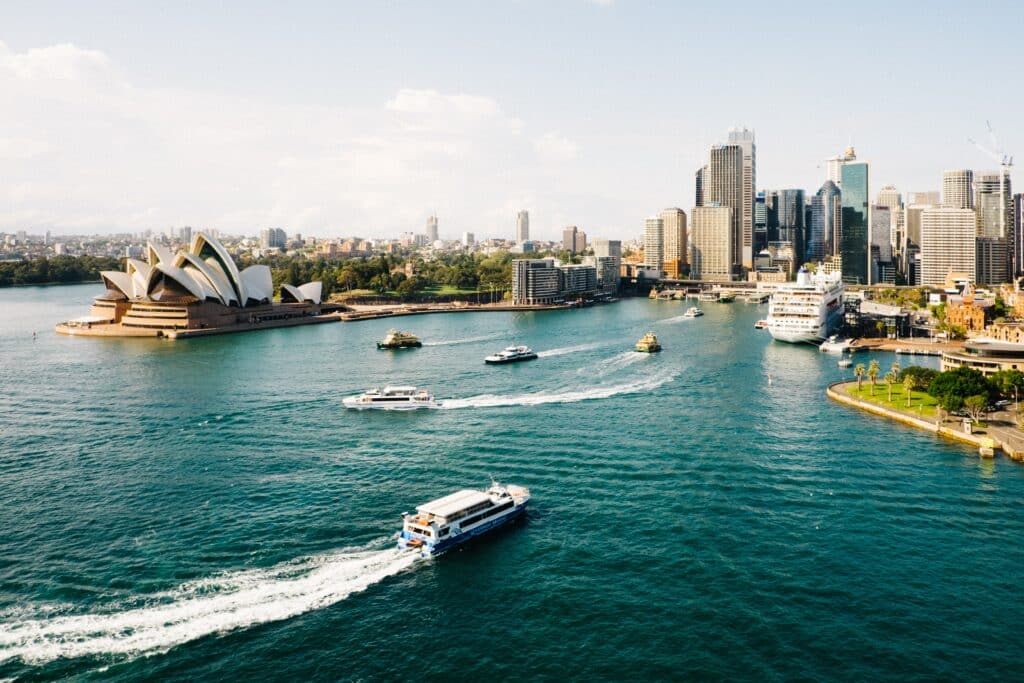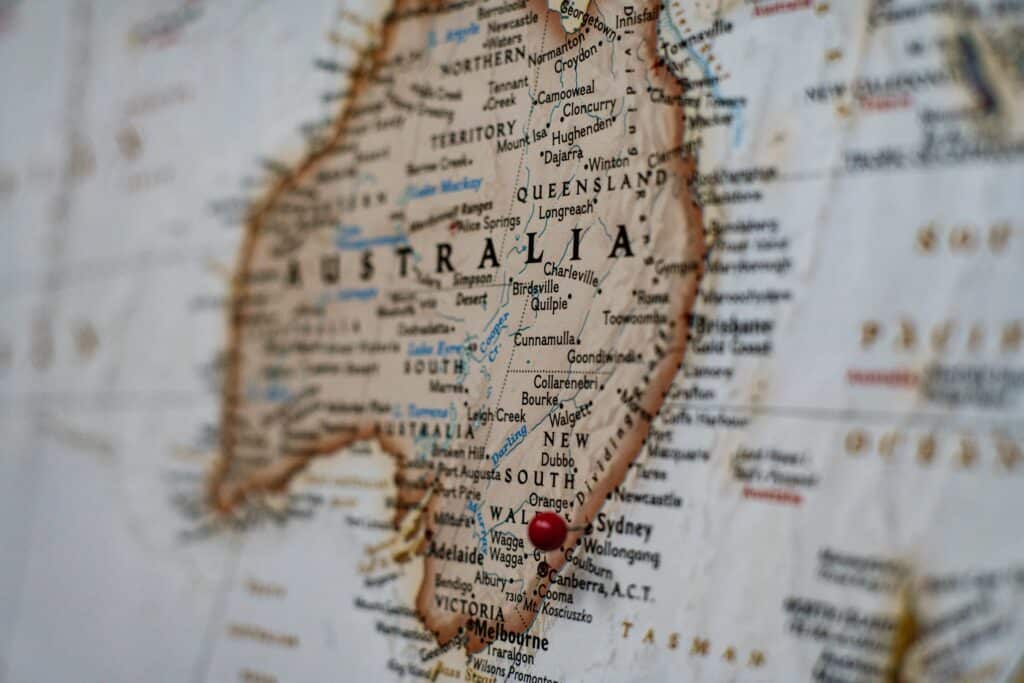From Outback Adventures to Coastal Bliss
Australia, the Land Down Under, isn’t just another travel destination. It’s a diverse continent that offers you a spectrum of experiences, from snorkeling in coral reefs to stargazing in the outback. This guide provides an all-encompassing view of Australia, ensuring you don’t miss out on anything it offers. Australia’s unique blend of cosmopolitan cities, rich indigenous heritage, and unparalleled biodiversity makes it a must-visit for any avid traveler.
From Sydney’s iconic cityscape to Melbourne’s cultural intricacies, and from the untouched natural beauty of the Great Barrier Reef to the rugged landscapes of the Outback, Australia captivates and enchants in every way. You could easily spend months exploring and still have more to discover.
Section 1: Preparing for Your Trip
Passport and Visa Requirements
Entering Australia requires thorough planning. You’ll need a valid passport with at least six months remaining. Visa conditions can be stringent and are divided into multiple subclasses. The most common types are the Electronic Travel Authority (ETA) visa and the Visitor visa (subclass 600). While the ETA is mostly for short-term visits and quicker to obtain, the Visitor visa is more versatile but usually requires a more rigorous application process. If you’re planning a longer stay, perhaps to study or work, there are specialized visas for those purposes. Always consult Australia’s official immigration website for the most accurate, up-to-date information. Applying for a visa well in advance is crucial as processing times can vary, and last-minute applications could disrupt your travel plans.
Packing Tips
Australia’s vast landmass is home to a wide range of climatic zones, which means packing can be a challenge. For Northern Australia, expect tropical conditions year-round. In contrast, Southern Australia experiences four distinct seasons. A general packing list should include lightweight clothing for summers and layers for winters, comfortable walking shoes, a versatile jacket, sunscreen, insect repellent, and perhaps a raincoat for unexpected downpours. If you’re venturing into the Outback, additional supplies like a wide-brimmed hat, sturdy boots, and extra water are a must.
Travel Insurance
Travel insurance isn’t something to overlook. Considering Australia’s range of adventurous activities—from snorkeling in the Great Barrier Reef to trekking through national parks—you’ll want comprehensive coverage that includes medical emergencies, evacuations, and any activities you plan to undertake. A good policy should also cover less dire situations like trip cancellations or lost luggage. It’s always better to have it and not need it than to need it and not have it.
Section 2: Arrival in Destination
Airport Information
Australia is served by multiple international airports, with Sydney’s Kingsford Smith Airport, Melbourne’s Tullamarine Airport, and Brisbane Airport being the major hubs. These airports are equipped with a plethora of amenities, from free Wi-Fi and charging stations to a wide variety of dining and shopping options. Currency exchange offices and ATMs are plentiful, but it’s advised to have some Australian dollars on hand upon arrival for smaller expenses like a coffee or a SIM card for your phone.
First Impressions
When you first step foot in Australia, you’ll likely be struck by how friendly and open the locals are. The country’s multicultural fabric is evident as you stroll through airport terminals filled with signs in multiple languages and shops selling international goods. Even in big cities, Australians tend to be laid-back and approachable. Whether you’re getting directions or asking for recommendations, you’ll be greeted with a friendly demeanor that sets the tone for your trip.
Section 3: Where to Stay
Hotels and Resorts
Accommodation options in Australia are as diverse as the country itself. For those on a budget, consider YHA Australia, a chain of hostels offering clean and affordable lodging. These hostels often include communal kitchens, free Wi-Fi, and organized social activities. In the mid-range, Mercure Hotels offer comfortable rooms with all the modern amenities you’d expect, including swimming pools and in-house restaurants. For a luxury experience, consider the Four Seasons Sydney, which offers unparalleled views of the iconic Sydney Harbour, top-notch service, and even a rooftop pool.
Local Homestays
For a more intimate experience, consider renting a local homestay or Airbnb property. This not only provides a unique perspective on how Australians live but also allows you to stay in residential neighborhoods that may be off the beaten path. Airbnb options range from city-center apartments to countryside cottages. Many hosts offer local advice and may even introduce you to some uniquely Australian experiences, like a backyard cricket match or a traditional barbecue.

Section 4: Exploring Destination
City Guides
Australia’s cities are vibrant and diverse, each offering its own set of unique experiences. Sydney, the most iconic, is a bustling metropolis known for its stunning harbor, vibrant arts scene, and world-class restaurants. Don’t miss climbing the Sydney Harbour Bridge or taking a tour of the Opera House. Melbourne, often dubbed the “cultural capital,” is famous for its maze of laneways filled with street art, boutiques, and cafes. Coffee culture is big here, so make sure to pause for a brew. Brisbane, often overlooked, has its own charm with its riverfront location, youthful energy, and thriving music scene.
Hidden Gems
While cities offer much to see, Australia’s hidden gems lie in its less-frequented spots. Kakadu National Park in the Northern Territory is an absolute must for those interested in Aboriginal culture and natural beauty. It’s a UNESCO World Heritage Site, offering a mix of archaeological and ethnological reserves. Another lesser-known but stunningly beautiful destination is the Freycinet Peninsula in Tasmania, home to the world-renowned Wineglass Bay.
Cultural Insights
Australia has a rich tapestry of cultures. Events like Vivid Sydney, a festival of lights, music, and ideas, illuminate the country’s artistic leanings. Australia Day, celebrated on January 26th, is another significant event but comes with mixed feelings, as it also marks the beginning of colonization, which had devastating impacts on Indigenous communities. Understanding the complex emotions surrounding this day will give you deeper insight into Australia’s history and diverse society.
Section 5: Food and Drink
Local Delicacies
Australian cuisine reflects its diverse cultural landscape. From indigenous bush foods like kangaroo and witchetty grubs to British-inspired meat pies, and from Italian pastas to Asian curries, you’ll find a smorgasbord of options. Some must-try dishes include Vegemite on toast—a uniquely Australian breakfast—and Barramundi, a succulent fish often grilled and served in high-end restaurants as well as local eateries.
Dining Etiquette
Australia is pretty laid-back when it comes to dining etiquette. Tipping is not as common as in countries like the U.S., although it’s appreciated for excellent service. Most restaurants include a Goods and Services Tax (GST) in the bill. However, rounding up the bill or leaving some loose change is a nice gesture. Always wait to be seated unless it’s a very casual establishment or a cafe.

Section 6: Outdoor Adventures
Hiking and Nature Trails
If you’re an outdoorsy type, Australia won’t disappoint. The Blue Mountains, just a short drive from Sydney, offer excellent hiking trails through
eucalyptus forests and past stunning cliffs. The Three Sisters is one of the most photographed landmarks in the area, so don’t forget your camera. Farther afield, the Larapinta Trail in the Northern Territory is a long-distance hike that showcases the raw beauty of the Outback. Always remember to carry sufficient water, sunscreen, and maybe a broad-brimmed hat to protect yourself from the harsh sun.
Water Activities
Australia is a paradise for water lovers. The Great Barrier Reef offers world-class snorkeling and diving opportunities. If you’re based in Sydney, the Bondi to Coogee coastal walk includes several spots where you can take a refreshing swim. Kayaking and paddleboarding are also popular activities on most Australian beaches. Always heed local advice about water conditions, as riptides can be a concern at some beaches.
Section 7: Art and Culture
Museums and Galleries
Australia’s rich history and diverse culture are well represented in its museums and galleries. The National Gallery of Victoria in Melbourne is the oldest and most visited gallery in Australia, housing more than 70,000 works of art. In Sydney, the Museum of Contemporary Art offers cutting-edge exhibits that are sure to inspire. For a deeper dive into Australia’s indigenous history, the Australian Museum in Sydney has an excellent Indigenous Australia exhibit.
Local Art Scene
In recent years, Australia’s local art scene has exploded with a new generation of artists gaining international acclaim. Melbourne’s laneways are now famous for their graffiti art, which has become a major tourist attraction in the city. Art festivals like Tasmania’s MONA FOMA and Sydney’s Vivid Festival are also pushing the boundaries and gaining worldwide attention.
Section 8: Nightlife and Entertainment
Live Music and Performances
Australia has a thriving live music scene. Melbourne is often considered the live music capital of the world, with more live music venues per capita than any other city. Sydney is not far behind and offers a variety of options, from intimate jazz bars to large concert halls. The Sydney Opera House, apart from its architectural significance, is a prime venue for world-class performances.
Nightclubs and Bars
Australia’s nightlife is vibrant and varied. Melbourne’s Chapel Street and Sydney’s Darling Harbour are hotspots for trendy bars and nightclubs. If you’re in Brisbane, Fortitude Valley is the place to be for live music and dancing. Always remember to carry ID, as most places have a strict age policy.
Section 9: Shopping and Souvenirs
Local Markets
Australia’s local markets offer a plethora of unique items. Sydney’s Paddington Markets are a great place to find handmade crafts, textiles, and gourmet food. In Melbourne, the Queen Victoria Market offers everything from fresh produce to unique Australian souvenirs. Remember to haggle, as most market vendors expect a bit of bargaining.
Shopping Malls and Boutiques
For those who prefer a more modern shopping experience, Australia’s cities offer a range of high-end boutiques and malls. Sydney’s Westfield is a shopper’s paradise, offering both international and Australian brands. Melbourne’s Emporium is a multi-level indoor shopping mall that features Australian designers and international high fashion.
Section 10: Travel Tips and Safety
Local Transportation
Australia is vast, and while its cities have well-developed public transportation networks, getting from one city to another is often best done by flying. Within cities like Sydney, Melbourne, and Brisbane, you’ll find a range of options from trains and buses to ferries. Purchase a local transport card like Sydney’s Opal Card or Melbourne’s Myki for the best rates and ease of use.
Health and Safety
Australia is a fairly safe country, but it’s essential to take precautions. Always swim between the flags at beaches, as the currents can be unpredictable. If you’re venturing into national parks or the Outback, be prepared for limited phone reception and always inform someone of your plans. Standard vaccinations are generally enough for travelers, but it’s advisable to consult your healthcare provider beforehand.
Section 11: Responsible Travel
Sustainable Practices
Australia is at the forefront of eco-tourism, with many hotels and tour operators implementing sustainable practices. Always respect nature, especially when visiting sensitive ecosystems like the Great Barrier Reef or national parks. Avoid using plastic bottles, and always dispose of your waste responsibly.
Supporting Local Communities
Buying local products and using local services not only enhances your travel experience but also helps support the community. Consider taking indigenous-led tours to learn about Australia from the people who have lived there for thousands of years.
Conclusion
Australia is a continent of extremes, featuring everything from cosmopolitan cities to rugged wilderness. Its friendly people, rich culture, and diverse landscapes make it a must-visit destination for any world traveler. Whether you want to explore the arts, enjoy unique cuisines, or take part in outdoor adventures, Australia has something to offer for everyone.
Appendix
Useful Phrases
- G’day: Hello
- How ya goin’?: How are you?
- No worries: It’s okay
Emergency Contacts
- Police, Fire, Ambulance: 000
- Poison Information: 13 11 26
- Emergency Services Text: 106 (for those with speech or hearing difficulties)




